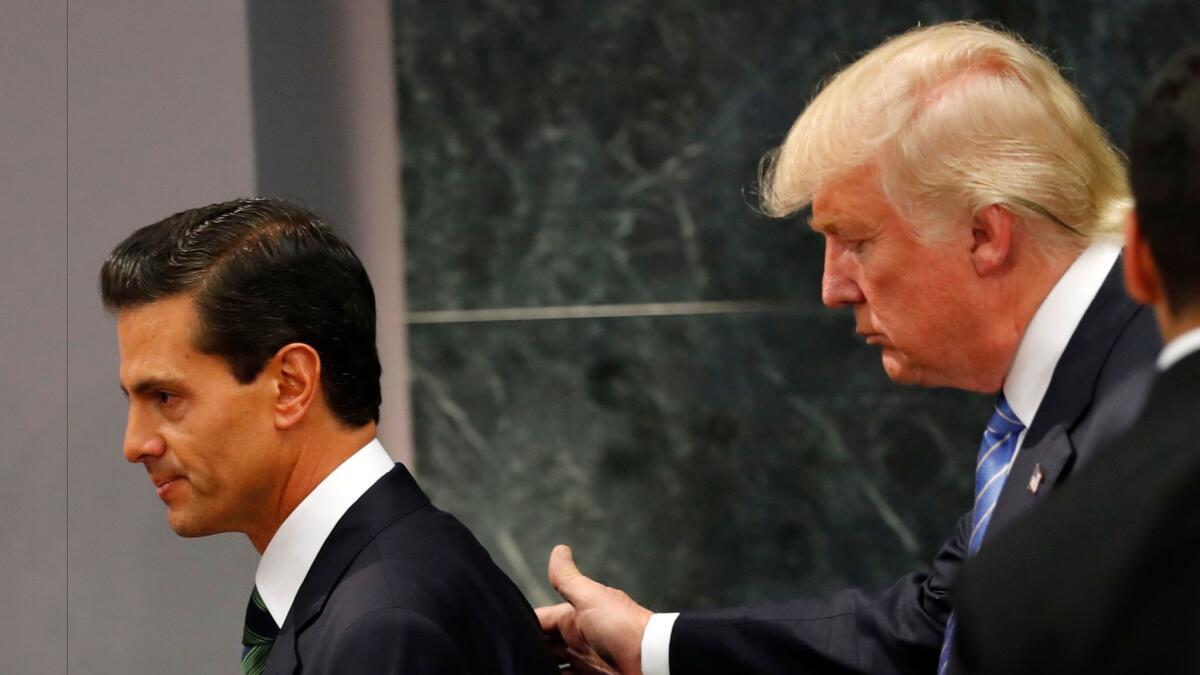Op-Ed: Trump might be stuck with NAFTA

After attacking the North American Free Trade Agreement repeatedly during his campaign, Donald Trump notably failed to include NAFTA on his agenda for his first day in the Oval Office. Perhaps he has learned that the Constitution prevents the president from terminating our trade agreements by himself.
Upon taking office, the new president will enjoy broad powers in foreign affairs. He will have the right to set U.S. policy toward other nations and to terminate treaties. In 2002, for example, President George W. Bush called off the Anti-Ballistic Missile Treaty between the United States and Russia without any input from Congress.
But trade agreements are different. Like all modern trade pacts, NAFTA is a congressional-executive agreement created by statute, not treaty. Trump cannot terminate it — or even renegotiate it — without the approval of Congress.
Under the Constitution’s Commerce Clause, only Congress may alter our tariff, tax and customs laws.
The Constitution grants to the president the power to make treaties, subject to approval by two-thirds of the Senate. Our nation’s most significant obligations take this form, such as the North Atlantic Treaty that created NATO and the San Francisco Treaty that ended World War II in the Pacific. Presidents also have made some limited international compacts all on their own, though the Constitution doesn’t acknowledge this power. President Obama concluded the Paris climate accords and the Iran nuclear deal without the approval of the Senate or House of Representatives. Because Congress never cemented these deals into law, Trump can reverse them with the stroke of a pen on Day One.
But trade deals are different, because under the Constitution’s Commerce Clause, only Congress may alter our tariff, tax and customs laws. Congress first authorizes the president to reach a trade agreement with certain countries within limited parameters. Once the deal is struck, the president sends it to Congress for enactment into U.S. domestic law. No trade agreement goes into force until Congress passes the statutes that carry out the trade deal’s obligations.
The upshot is that President Trump cannot on his own terminate U.S. participation in NAFTA or, for that matter, in the World Trade Organization. Congress enacted both agreements as statutes, so they can be reversed only by another, repealing statute enacted by the House and the Senate and then signed by the president.
This constitutional balance of power effectively means that NAFTA and the WTO are here to stay. Both houses of Congress are more friendly to free trade. In the Senate, a minority of just 40 Senators could successfully filibuster any effort to terminate NAFTA. Trump is unlikely to persuade a new Congress to thoughtlessly throw the U.S. into recession and spark retaliatory trade sanctions against American products.
If Trump simply announced that the United States was pulling out of NAFTA, all the U.S. laws that implemented it would remain unchanged. Trump would have effectively freed Mexico and Canada to impose trade barriers against our products while leaving in place our preferential treatment of theirs — the worst trade deal in American history.
Even if Trump wants to merely renegotiate NAFTA, he is required to first seek congressional approval. No nation will even discuss trade agreements with the United States unless Congress is already on board. Presidents must first seek “fast-track” authority, a promise of swift congressional consideration of trade agreements with no amendments, before negotiations begin. Any amendments to NAFTA would likewise have to be enacted by Congress.
Moreover, a unilateral Trump decision to leave NAFTA would almost certainly be challenged in federal court immediately. In 1980, the Supreme Court avoided deciding a legal challenge to President Carter’s termination of a defense treaty with Taiwan because no one had the proper standing to bring a case. That won’t be the case this time. Importers or exporters directly affected easily could show they suffered individual harm. A lawsuit could derail any attempt by Trump to withdraw from NAFTA — or at the very least, drag out the process for years.
The Constitution still preserves presidential initiative in foreign affairs. Trump can refuse to negotiate or sign new trade agreements, such as the Trans Pacific Partnership, which is why TPP is probably dead on arrival under the new administration. But the Constitution makes undoing a trade agreement, once enacted into law, as difficult as it was to make it in the first place.
Whether the United States should leave NAFTA is an issue open to political debate. But who gets to decide to leave is not. The Constitution requires that the president and Congress must jointly agree whether to leave NAFTA.
Julian Ku is a law professor at Hofstra University Law School. John Yoo is a law professor at UC Berkeley and a visiting scholar at the American Enterprise Institute.
Follow the Opinion section on Twitter @latimesopinion and Facebook
More to Read
A cure for the common opinion
Get thought-provoking perspectives with our weekly newsletter.
You may occasionally receive promotional content from the Los Angeles Times.










